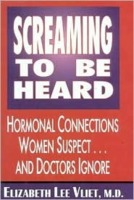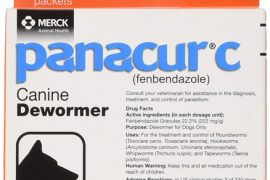(Excerpted from Dr. Elizabeth Lee Vliet’s forthcoming book: The Savvy Woman’s Guide to Estrogen: What America Got Wrong. . . and How To Do It Right)
Many of you saw the national news reports in late February 2007 announcing the findings of the ESTHER study, sponsored by health agencies of the French government. ESTHER, which stands for Estrogen and Thromboembolism Risk, showed that women taking oral estrogens were four times more likely to have a blood clot than women using estrogen in a transdermal gel or patch delivery. In fact, the women using estradiol gel or patches had no more blood clots than women using no hormones at all (placebo)! 56% of ESTHER women on transdermal therapy were using estradiol gel.
I wrote about lower risk of blood clots with non-oral estrogen in the first edition of Screaming to Be Heard, published in 1995. Studies since the 1970s have shown this important difference between oral and transdermal estrogen. Research data has become even stronger to support this longstanding observation that differences in the way hormones are delivered play a major role in safety vs. complications.
In the United States, this research comes as a surprise to women and most doctors. But French women and their doctors have known about these differences for over thirty years…what gives? The answer may lie in the different types of hormone products doctors prescribe in the U.S.A. and Europe.
American women have traditionally been given oral pills of Premarin (a mixture of horse estrogens) or Prempro (horse estrogens plus a potent synthetic progestin). Both products contain hormones that are foreign to the human body, and not identical to anything women make naturally. Yet, these two products alone have accounted for 80 to 85% of all hormone prescriptions in the United States for the last fifty years!
European women, on the other hand, have traditionally used products with bioidentical estradiol and progesterone, hormones that are identical to what the human body makes.
But even more critical is the difference in route of delivery here in the U.S.A. compared to Europe: 70% of women in France and Italy, for example, use transdermal forms of estradiol such as gels, lotions or patches that have been approved by their regulatory bodies (like our FDA). Contrast that 70% with the U.S. statistics: only 3% of American women use a transdermal form of estradiol, even though British researchers first published studies in the 1970s showing reduced risk of blood clots with non-oral estrogen.
One of the most successful options overseas, EstroGel, a pleasant, easy-to-use clear gel containing bioidentical estradiol, was approved by the French equivalent of the FDA about 30 years ago! Today, EstroGel is the most widely used form of estradiol in Europe. Even though EstroGel has been used so successfully in European countries for so many years, American women did not get this product until the FDA approved it in February 2004! So it seems the French have handled women’s hormone therapy a lot better than the Americans have for a long, long time!
Keep in mind, all of the various products using 17-beta estradiol deliver the identical molecular copy of a woman’s premenopausal estrogen.
Transdermal estradiol products deliver the human 17-beta estradiol in a way that is the most “natural” of all. The estradiol is absorbed through the skin, directly into the bloodstream, similar to the release of hormones from the ovaries. Direct delivery to the bloodstream bypasses the “first pass” metabolism in the liver that breaks down and changes estradiol into other forms that may not be as effective for its normal functions.
The primary difference between pill form and transdermal gel/patch is that oral estrogens all have to be metabolized (changed) first in the liver, called the “first pass” effect. Everything we eat swallow by mouth goes through the liver first so it can be changed into compounds that can be carried in the bloodstream. This first pass through the liver stimulates production of some clotting factors and proteins that lead to both pluses, and minuses, or oral medications.
One “plus” of oral estrogen is that it stimulates the liver to make more of the “good” cholesterol, or HDL. That means if you are a woman who has a very low level of HDL, you may need this boost in production provided by oral estrogen for the heart-protective effects of HDL. EstroGel, Estrasorb lotion or the patches (Climara and Vivelle DOT) still give you the natural physiological benefits of estradiol to maintain the normal level of HDL cholesterol. They just don’t give you that “first-pass” liver stimulation to ramp up production of HDL.
The “minuses” of oral estrogen can lead to a higher risk of blood clots: the liver “first-pass” effect can stimulate more production of clotting factors that in some women can cause deep vein thrombosis (DVT), or blood clots to the lungs, called pulmonary emboli (PE). Obesity, smoking, and inactivity, and genetic mutations like Factor V Leiden (a blood coagulation disorder) further increase the risk of clots.
Other “minuses” of oral estrogens, particularly mixed equine estrogens like Premarin, include stimulation of liver production of triglycerides (a blood fat associated with increased risk of heart disease if too high), renin (a substance that can cause high blood pressure), and greater likelihood of gallstones if you have a predisposition to those problems.
American women often say that “pills are easier” and they don’t want to be bothered with putting on the gel, or they don’t like the look of the “ring” with the patches as the adhesive around the edge picks up lint from clothes. But if it makes an important difference for your health, aren’t these pretty minor problems?
Apparently French women think so—and the widespread use of EstroGel throughout Europe attests to its ease of use and pleasant, non-greasy feeling on the skin. So maybe it’s time for you to get savvy and take advantage of the estrogen benefits and lower risks that European women have known for so long!
Advantages of transdermal delivery include:
- Transdermal delivery bypasses the first step in the liver that oral medicines undergo. It is this “first pass” in the liver that causes an unwanted increase in clotting factors that lead to higher risk of blood clots;
- It maintains steadier blood levels of estradiol, similar to the hormone production by the ovary (helpful for women with
blood pressure or “hormonal” headache problems); - It leads to better improvement in glucose control and insulin sensitivity than with oral estrogens;
- It causes less rise in blood level of estrone, the estrogen of body fat, than seen with oral estrogens, again because transdermal estradiol bypasses the liver “first pass;”
- The estradiol is less likely to be adversely affected by other medications, since it is not metabolized first in the liver;
- Transdermal delivery of estradiol does not elevate triglycerides as occurs in some women taking oral estrogens;
- Non-oral estradiol is less likely to cause gallstones;
- Transdermal estradiol helps maintain a premenopausal healthy balance of good HDL to bad LDL cholesterol even though it doesn’t raise HDL as rapidly or quite as high as oral estrogens.
The bottom line is that many of the health risks you have heard about from “estrogen” in the headlines over the last five years have been based on the Women’s Health Initiative studies using only horse-derived oral estrogens and synthetic progestins. My clinical experience over twenty years, and the international research, show that those risks don’t apply in the same way to all other types of estrogens and other ways of giving the hormone, such as transdermal.
The WHI—which studied older postmenopausal women using either Premarin alone if they had a hysterectomy, or Prempro(horse estrogens plus medroxyprogesterone acetate, a potent synthetic progestin) if they did not—is the major U.S. study that has caused so much turmoil and confusion about hormones since 2002. The WHI was presented in the press as a study of “healthy” menopausal women.
Healthy? Only in America would we call women with these characteristics “healthy!” No country in Europe has such a high percentage of hypertension or obesity, both of which are risk factors for stroke, heart disease and breast cancer. Consider these statistics from the WHI study data:
- 35% of the women were already being treated for high blood
pressure. - 35% were significantly overweight.
- Another 34% were obese by the medical definition, making
a total of 69% of the entire study group having an abnormal
body mass index, which affects all kinds of health risks from
breast cancer to cardiovascular disease. - 12.5% had high enough cholesterol to require medication.
- 16% had a family history of breast cancer.
- 4% had diabetes.
- 40% were former smokers, and 10% continued to smoke cigarettes during the study.
These women were “typical” Americans maybe, but certainly not “healthy.”
The only thing meant by healthy in the published research studies was that the women in the study just didn’t have symptoms of menopause! I’ll bet you didn’t even know that the WHI even excluded women experiencing hot flashes! Seems strange, doesn’t it?
Older women in the WHI already had evidence of heart disease, high cholesterol and high blood pressure. So these baseline problems affect the response to hormones, especially when high dose, “unnatural” products are used in women so long after menopause.
Recent worldwide research on hormone use has shown there is a “window of opportunity” early in the menopause transition for hormone therapy to prevent damage to various tissues and organs. Once this window of time is past, however, hormone therapy doesn’t reverse damages that have occurred. This was demonstrated clearly in the Women’s Health Initiative using Premarin and Prempro in elderly postmenopausal women.
The International Menopause Society position paper in September, 2002, said: “The WHI results, and particularly the data on cardiovascular disease risk, should only be related to the continuous combined treatment of 0.625 mg CEE (conjugated equine estrogens, Premarin) together with 2.5 mg MPA (medroxy-progesterone acetate), prescribed to elderly, obese women with characteristics similar to those depicted in the WHI study”.2 (Parenthetical explanations by Elizabeth Lee Vliet, M.D.).
In fact, the above comments and WHI findings validate concerns I have been raising about Premarin and Prempro in my previous books and medical articles since the early 1990s.
And now, French researchers have given us even more fuel for the fire that there are other, safer ways to use estrogen— ways that help you feel better, feel more vital and energetic, and not have all the risks you have read about in the press.
Now it’s time for American women to appreciate, and benefit from, the differences in type of estrogen and how it can be given to better meet individual needs. If you are using, or considering, estrogen to relieve menopausal symptoms, ask your doctor if you can try EstroGel or one of the patch brands that are FDA-approved bioidentical options for estradiol.
As the French say, Vive la difference!
© 2007 Elizabeth Lee Vliet, M.D., Permission to reprint in whole (Not in part) is gladly granted, provided full credit is given. Visit Dr. Vliet at her main office in Tucson and explore much more at her website, www.HerPlace.com aka HER Place®




